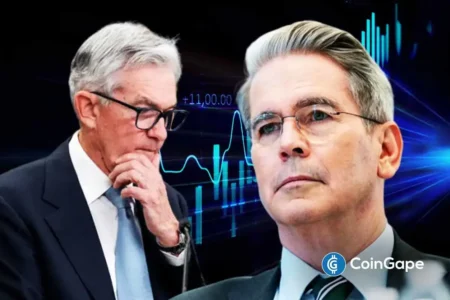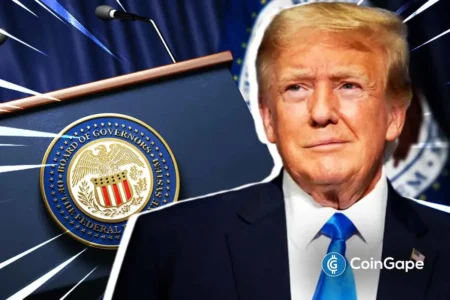Bitcoin’s Surge: The Role of Trump’s Tariff Reversal and Market Dynamics
Bitcoin (BTC) has recently made headlines, surging above $84,000—an impressive rise of over 8%—shortly after former President Donald Trump unexpectedly reversed his administration’s global tariff plans. Initially aimed at all U.S. trading partners, Trump’s shift to a flat 10% tariff (excluding China) has assuaged investor fears surrounding a potential trade war. This economic pivot has not only provided relief but also validated the predictions made by BlackRock CEO Larry Fink earlier in the week, where he suggested that such uncertainty could present attractive entry points for long-term investors.
This noteworthy price movement can largely be attributed to a sharp rebound in Bitcoin that occurred following Trump’s change in tariff policy. The cryptocurrency saw an increase of approximately 12%, climbing from an intraday low of $74,700 to a high of around $83,600—marking the most significant single-day price surge since March. Additionally, this bullish trend wasn’t confined to Bitcoin alone; other major altcoins like Ethereum, XRP, Cardano, Solana, and Dogecoin also experienced double-digit gains, indicating a broader positive sentiment across the crypto market.
Larry Fink’s predictions echoed loudly as Bitcoin’s impressive rebound unfolded. In remarks made at the Economic Club of New York, Fink suggested that broad tariffs could instigate a 20% correction in global markets, but also viewed such a downturn as a ripe buying opportunity. His perspective aligns with the recent tariff changes, signifying that the evolving landscape may indeed be advantageous for savvy traders looking to capitalize on market volatility. Market participants appeared to interpret the tariff reversal as a green light for reentry into the cryptocurrency space, reinforcing Fink’s optimistic outlook amidst the uncertainties.
As the crypto market reacted swiftly, on-chain data from CryptoQuant indicated an influx of Bitcoin deposits on Binance, which increased significantly during the recent market turbulence. From March 28 to April 10, Binance showed a surge in BTC deposits from approximately 2.42 million to 2.44 million. This influx, valued at about $1.34 billion given Bitcoin’s current price, suggests a growing interest among investors who are keen to respond quickly to market movements. Heightened exchange activity is often a signal of investor anxiety, compounding short-term supply and consequently amplifying market volatility. Until we see a trend of rapid withdrawals indicating a shift towards long-term holding, the current influx suggests a focus on short-term opportunities among active traders.
Looking ahead, Bitcoin faces a critical resistance level around $88,800, stemming from an earlier peak observed in the wake of Trump’s initial tariff announcements. This level corresponds with the upper limit of the Keltner channel on the 12-hour BTC/USD chart, suggesting a significant barrier to upward movement. The potential for profit-taking by traders positioned at lower levels of the recent correction could reinforce a sell-wall scenario, creating challenges for Bitcoin’s ascent toward the coveted $100,000 mark. The market is in a state of anticipation, especially with upcoming inflation data releases from both the U.S. and China, which could provide further clarity on Fink’s forecast and rejuvenate bullish market momentum.
While the immediate sentiment appears cautiously optimistic, the looming risk of a retracement cannot be overlooked. Should inflation figures exceed market expectations, a shift in monetary policy outlook could prompt a wave of risk-off behavior across the market. A particular focus would be on the lower Keltner Channel band around $73,500, which represents a critical support zone. If Bitcoin breaches the $80,000 mark—especially amidst rising selling volume—it could trigger heightened downward pressure, compelling traders to reconsider their strategies and exposures.
In conclusion, the short-term outlook for Bitcoin has undeniably improved, yet the cryptocurrency faces significant challenges in breaking through the $88,800 resistance to transform the $100,000 target from mere speculation into actionable reality. Should inflation data and investor sentiment remain favorable, a continued breakout could unfold. However, a failure to maintain support around $80,000 may catapult the market towards a retracement near $73,500, particularly if broader macroeconomic headwinds resurface. As we witness these dynamics, traders and investors alike will need to stay vigilant and strategic in navigating the complex landscape of cryptocurrency trading.
Frequently Asked Questions (FAQs)
-
Why did Bitcoin rally over 8% recently?
Bitcoin experienced a substantial rally following Donald Trump’s unexpected reversal of expansive tariff plans, reigniting investor confidence. -
What was BlackRock CEO Larry Fink’s prediction regarding the market?
Fink suggested that broad tariffs might lead to a 20% market dip, framing it as a potential buying opportunity, which gained traction in the wake of Trump’s policy shift. -
What does the recent inflow of $1.34 billion to Binance indicate?
The influx of Bitcoin deposits signals a short-term trading focus among investors, highlighting readiness for high volatility reactions in the crypto market. -
What resistance level is Bitcoin currently facing?
Bitcoin is approaching a significant resistance level near $88,800, a crucial point that traders need to watch closely as it aims for the $100,000 milestone. - What are the risks that Bitcoin faces in the near future?
A potential retracement could occur if inflation figures exceed expectations, with the $73,500 support level marking a critical threshold for traders to monitor.
As you explore the cryptocurrency landscape, ensure to stay informed and conduct thorough research to make educated investment decisions.
















